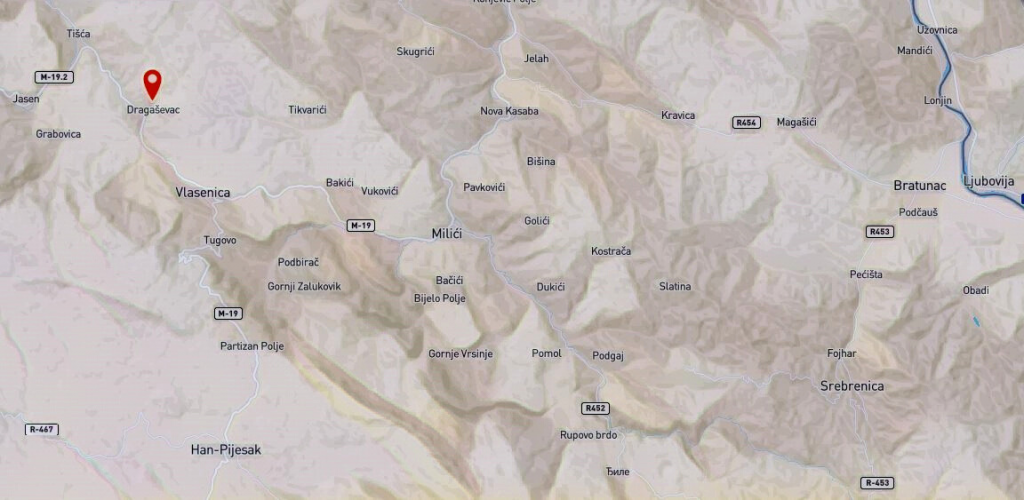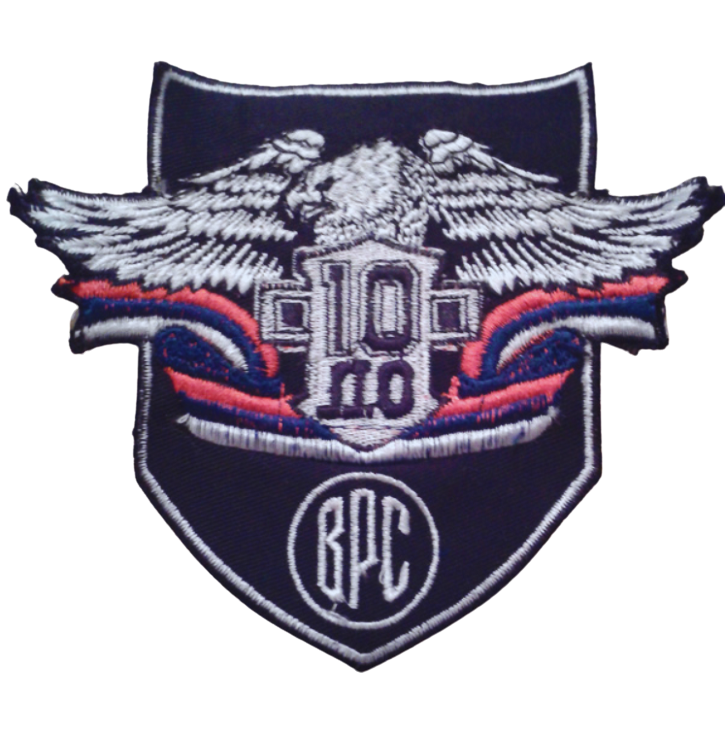
The 10th Sabotage Detachment (the 10th SD), a unit of the Main Staff of the Army of Republika Srpska (MS VRS), participated in the commission of genocide in Srebrenica in July 1995. It has been established that members of this detachment took part in two mass executions of Bosnian Muslims from Srebrenica in July 1995 – one that took place on 16 July at the Branjevo military farm, where about 1,200 Muslim prisoners from Srebrenica were killed, and another in the village of Bišina on 23 July 1995, where at least 39 Muslim prisoners were killed.
Structure of the 10th Sabotage Detachment
The 10th Sabotage Detachment of the Army of Republika Srpska was formed on 14 October 1994 on the orders of General Ratko Mladić, Commander of the VRS, as a sabotage unit directly subordinated to the VRS Main Staff (MS).
General Zdravko Tolimir, Chief of the VRS MS Department for Intelligence and Security Affairs, was the second-in-command, commanding the unit in the absence of General Mladić. Colonel Petar Salapura, Chief of the VRS MS Intelligence Administration, was responsible for conveying the VRS MS orders and directives to the 10th Sabotage Detachment and supervising their execution on the ground.
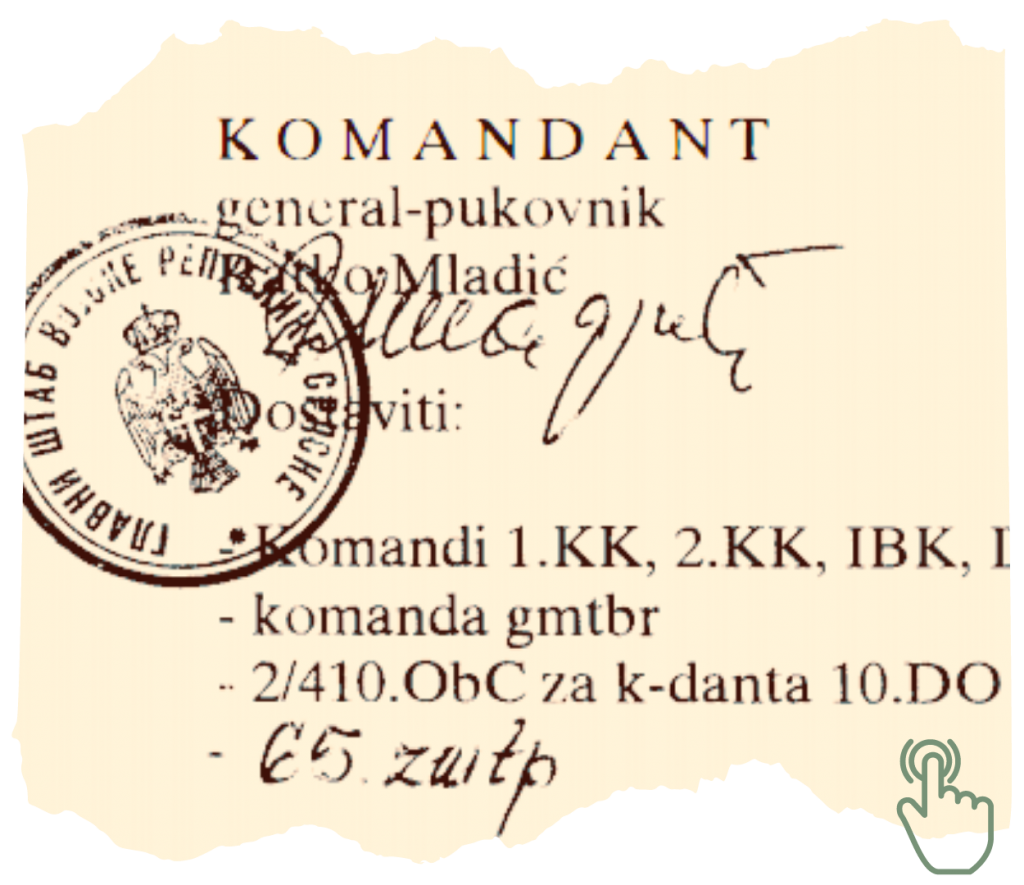
Major Dragomir Pećanac, the first adjutant to Ratko Mladić, also had the authority to give orders to the unit. Most orders were orally communicated to the unit, and the communication between the commanders and their subordinates was also oral.
Lieutenant Milorad Pelemiš was appointed commander of the unit at the time it was formed, in October 1994. Luka Jokić, a.k.a. “Lule”, was appointed Pelemiš’s deputy.
The detachment had between 50 and 60 soldiers in two platoons: The 1st Platoon (the Bijeljina Platoon), commanded by Franc Kos, and the 2nd (Vlasenica) Platoon, commanded by Luka Jokić. The Vlasenica Platoon was an assault platoon, while the Bijeljina Platoon was a sabotage platoon.
Command structure of the 10th Sabotage Detachment in 1995
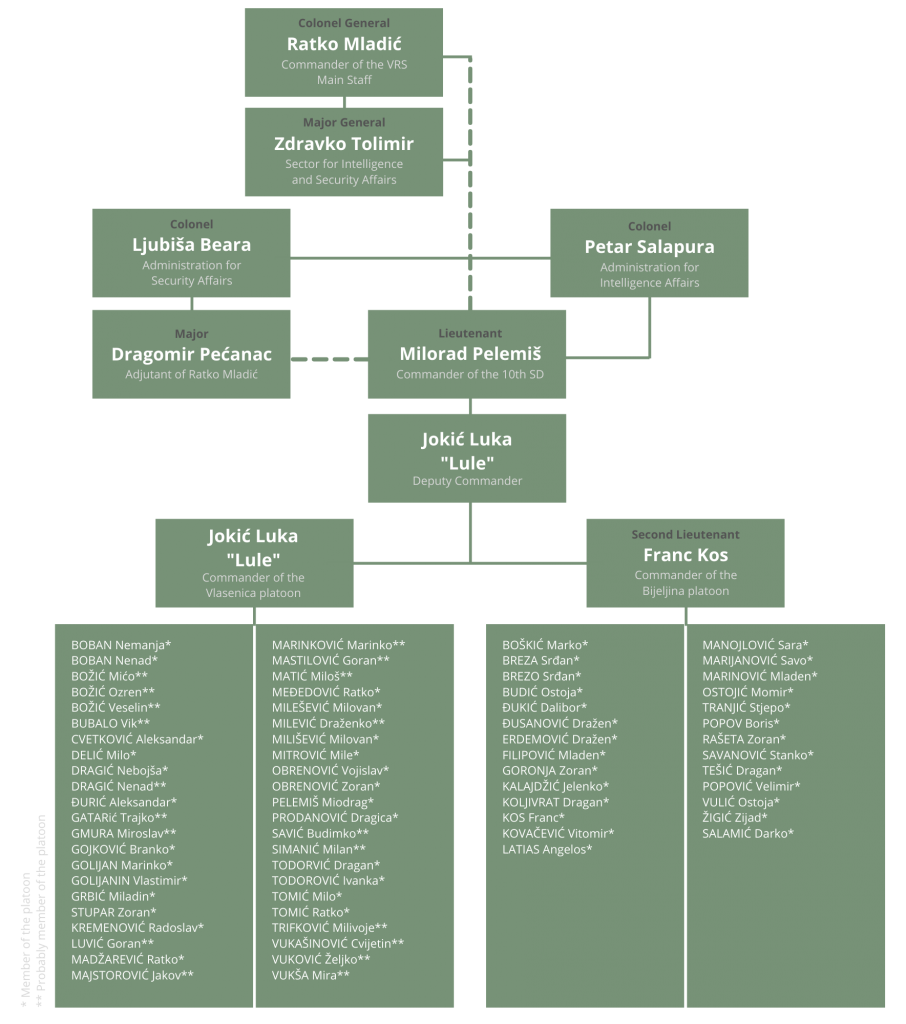
Members of the 10th Sabotage Detachment wore various uniforms: black coveralls with the 10th SD insignia; two-piece VRS camouflage uniforms with the 10th SD insignia; United States Army uniforms; Army of Bosnia and Herzegovina (ABiH) uniforms; and Croatian Defence Council (HVO) uniforms.
Soldiers, including several Croats, one Slovene and one Muslim, joined the detachment upon signing a two-year professional service contract with the VRS.
This elite detachment was primarily tasked with the collection of intelligence on the parties to the conflict, penetrating the enemy rear areas, and conducting sabotage and diversionary actions.
Members of the detachment underwent at least two training courses. The first was a twenty-day training course organised in late 1994 at the “Vojna Pošta (VP) 5000” military barracks in Pančevo. The second was held in February 1995 in Vlasenica, pursuant to an agreement reached between Colonel Petar Salapura and Yugoslav Army (VJ) General Mile Mrkšić. The training was delivered by three VJ instructors, who arrived at the military garrison in Bijeljina for that occasion.
Operations of the 10th Sabotage Detachment
The unit carried out one of its first operations in late 1994. The detachment was sent to Bihać at the time the Bosnian Serbs were taking over the Bihać area. The goal of the operation was to introduce the detachment to its commander, Milorad Pelemiš.
The next operation took place in the spring of 1995 in Žepa. The detachment was assigned the task of penetrating the Žepa defensive line alongside the 1st Podrinje Brigade. After an hour-long wait along the line, two unknown men arrived and exchanged fire with members of the VRS. The detachment left the area as soon as the firefight began.

June 1995
On the night of 24 June 1995, about 30 members of the 10th SD, acting in tandem with the Intervention Platoon of the Bratunac Brigade, entered Srebrenica through a tunnel of the Sase mine. Having passed through the tunnel, they arrived at a hill overlooking the town of Srebrenica, from where they opened indiscriminate fire from mortars and rocket launchers at Srebrenica, while the Intervention Platoon released bursts of gunfire at nearby houses. 19 shells were fired. After the attack, the soldiers retreated back through the tunnel and returned to Bratunac.

(ICTY translation)
According to a report from the Dutch Battalion, two civilians were wounded and one was killed as a result of this attack.
The aim of this action was to cause havoc and panic among the civilians in the enclave and demonstrate the strength and power of the VRS to the Army of BiH and the UN forces.
Milorad Pelemiš commanded the action, which was carried out pursuant to Petar Salapura’s order issued to the 10th Sabotage Detachment on 21 June 1995 to begin “intense preparation” for carrying out an operation which was to be kept strictly secret.
The case of two Muslim prisoners from Srebrenica
In late June 1995, the 10th SD apprehended two Muslim men as they tried to leave Srebrenica. The captives were used for collecting information concerning the movements of the Army of BiH near Srebrenica.
After the necessary intelligence was collected from the two prisoners, Milorad Pelemiš ordered Dragan Todorović and another, unidentified member of the detachment to take one of the prisoners, Mujo, to a deserted village and kill him, which they did. The fate of the other prisoner is unknown.
Dragomir Pećanac submitted a report to the VRS Main Staff Intelligence Administration on the questioning of war prisoner Mujo Muškić on 28 June 1995. Muškić was questioned in order to gather information from him regarding the direction of “the movement from Srebrenica of a group of Muslims that he was part of, until the moment he was captured”.
Operation Krivaja-95: The takeover of the UN safe area of Srebrenica
The VRS Main Staff, more specifically Petar Salapura, on 10 July 1995 ordered the 10th Sabotage Detachment to conduct the necessary preparations and launch the operation aimed at taking over the UN safe area of Srebrenica. In pursuance of this order, Lieutenant Pelemiš later that day issued an order to his subordinates, 15 from each platoon, to start marching on the Bijeljina–Vlasenica–Bratunac route.
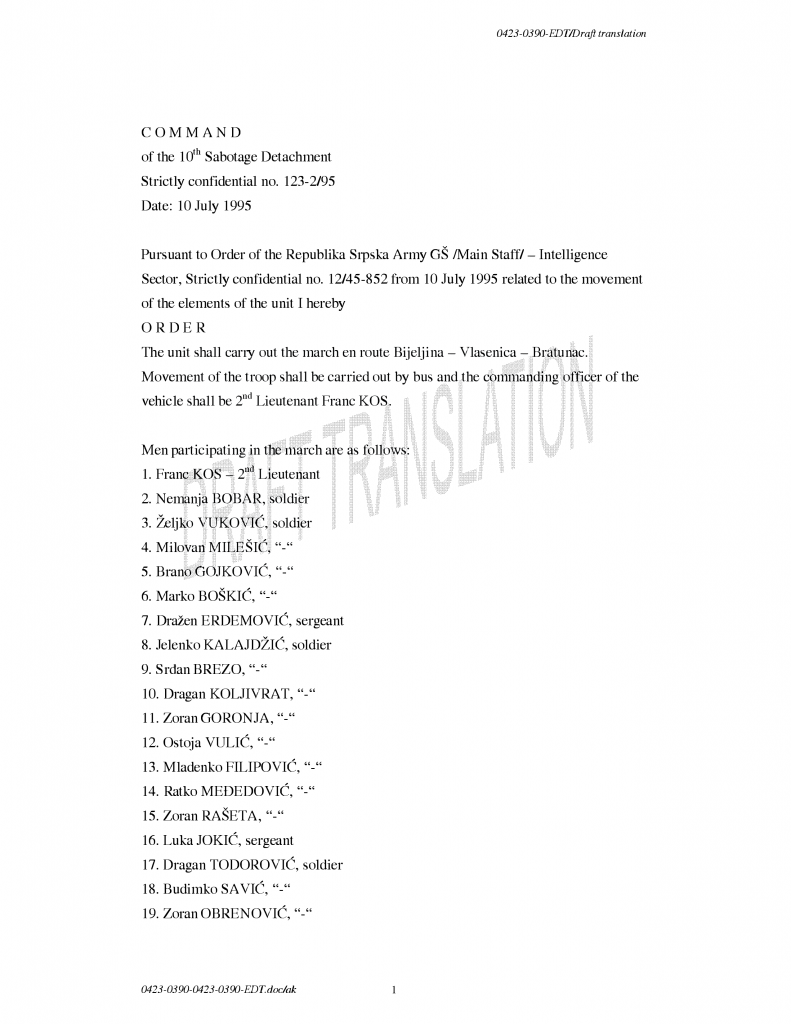
Before they left, the soldiers were given red armbands to wear to distinguish themselves from members of other units. About 15 members of the “Vukovi sa Drine” [“Drina Wolves”] unit were attached to the 10th SD and put under the sole command of Milorad Pelemiš.
The 10th Sabotage Detachment spent the night of 10-11 July near Zeleni Jadar, on a hill just a few kilometres from Srebrenica.
The Srebrenica takeover operation began in the early morning hours of 11 July 1995. That same day, between 13:00 and 14:00 hours, the detachment, divided into four groups of soldiers, entered the centre of Srebrenica, encountering no resistance. As soon as they entered the town centre, they started calling on the people who had remained in the town to leave their houses. About 200 civilians responded to the calls and walked to the football field on the opposite side of the town. These were mainly elderly people with mobility problems.
Members of the detachment searched the houses in Srebrenica, looting valuables and, with Pelemiš’s consent, loading them onto trucks.
“When we arrived there, a civilian, wearing civilian clothing, surrendered and said, ´I was never in the army´.” […] “Later on, when we had already got there, the units descended from the surrounding hills and oneparticular group started to mistreat that young man, to beat him with rifles, with their fists, kick him and so on. And after that, perhaps a minute or two after all of that abuse, Pelemis ordered one of thesoldiers to go and slit that man’s throat”
Testimony of Dražen Erdemović in Krstić, ICTY, 22. May 2000
Milorad Pelemiš ordered that one part of the detachment take up positions at the southern entrance to the town, and to form a checkpoint there and report back to him as soon as General Ratko Mladić arrived. The other part of the detachment was ordered to guard and search the police station that was previously used as the headquarters of forces under the command of Naser Orić.
By the afternoon, Ratko Mladić, Commander of the VRS Main Staff, Radislav Krstić, Chief of Staff of the Drina Corps, Milenko Živanović, Commander of the Drina Corps, Vujadin Popović, Assistant Commander of the Drina Corps in charge of security, and Vinko Pandurević, Commander of the Zvornik Brigade, all arrived in Srebrenica, together with other soldiers. The officers congratulated members of the 10th SD for successful completion of the operation.
A number of members of the 10th SD spend the night of 11-12 July in Srebrenica protecting the town. On the morning of 12 July, they were ordered by Pelemiš to return to Vlasenica. The order was passed on by Zoran Stupar, a member of the detachment.
Forcible transfer of the Muslim population from Srebrenica and murder of military-age Muslim men in the period 12 – 23 July 1995.
12 July 1995
On the night of 11-12 July, General Ratko Mladić and his subordinates began preparations for the killings of Muslim men from Srebrenica. By the night of 11 July, they knew that there were between 1,000 and 2,000 Bosnian Muslims of military age in Potočari, and planned to take them prisoner on 12 July.
Members of the 10th Sabotage Detachment, alongside the military police unit of the Drina Corps, the 65th Protection Regiment, the 2nd and 3rd Battalions of the Bratunac Brigade, the military police unit of the Bratunac Brigade and MUP forces participated in the forcible separation, capture and killing of Muslims of military age, and in the transportation of the Muslim population from Srebrenica to Kladanj.
On 12 July 1995, Milorad Pelemiš, Velimir Popović, Brano Gojković, Mladen Filipović and Dragan Koljivrat went to Nova Kasaba, where Muslims captured by the VRS were held. They separated from the group a young man from Srebrenica who they knew was rich, led him to his house, took 100,000 German marks from him, and then killed him.
On the night of 12-13 July, Dragan Koljivrat, a member of the 10th SD, was killed and Pelemiš and Mladen Filipović were injured, when the personnel carrier that members of the 10th SD had seized from the UNPROFOR overturned. Pelemiš and Filipović were transported to the hospital in Milići.
13 July 1995
After being released from hospital on the morning of 13 July, Pelemiš returned to the base in Dragaševac, and ordered Dražen Erdemović, Dragan Todorović, Željko Vuković, Nebojša Gagić, Srđan Brezo and three or four other members of the Vlasenica Platoon to transport Dragan Koljivart’s body to Trebinje and attend his funeral the next day.
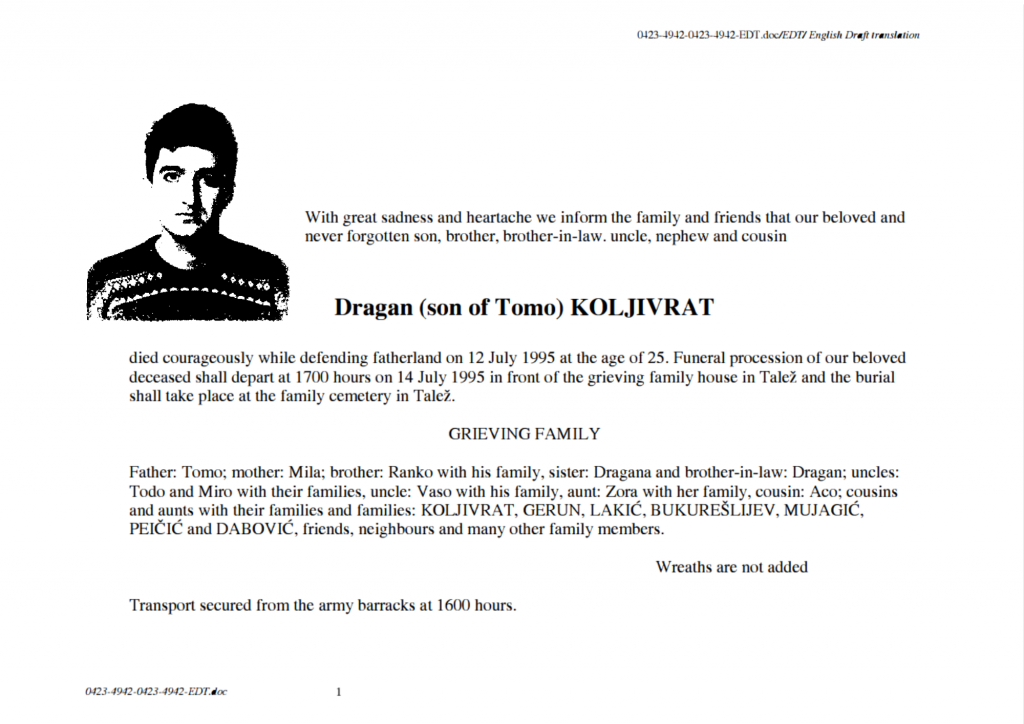
After that, Pelemiš, Franc Kos and Marko Boškić went to Konjević Polje. They stopped on the way to make a brief visit to the command post of the Vlasenica Brigade, where Pelemiš talked to several people, including General Radislav Krstić.
Pelemiš, Kos and Boškić then stopped in the village of Kravica. A column of Muslim civilians heading for Bratunac and escorted by the police of Republika Srpska passed by them. The officers parked their Mercedes Puch on the side of the road, next to a place where several officers were standing. Pelemiš talked to the officers, after which he, Kos and Boškić walked to the Kravica farm warehouse. They saw piles of dead bodies outside and inside the warehouse, and witnessed the execution of Muslim prisoners which was under way inside the warehouse.
Without further delay, Pelemiš, Kos and Boškić drove back to Dragaševac, where they arrived late in the night.
14 July 1995
On the morning of 14 July, Milorad Pelemiš said to his unit that four soldiers were needed to guard some prisoners. He picked Zoran Obrenović, Aleksandar Cvetković, Boris Popov and one more member of the 10th SD to carry out this task. Over the next two days, the soldiers would leave in the morning for an unknown location in the direction of Vlasenica, and return to the base in the evening.
15 July 1995
Early in the morning of 15 July 1995, Colonel Ljubiša Beara, Chief of Security Administration, phoned the 10th SD base in Dragaševac asking for seven to eight soldiers to come to Vlasenica. As Milorad Pelemiš was not there to approve Beara’s request, the soldiers were not sent to Vlasenica. An hour later, Beara informed the base in Dragaševac that Pelemiš would be back soon.
Before long, Milorad Pelemiš, Dragomir Pećanac, Vujadin Popović, Zoran Obrenović, and Luka Jokić arrived at the base. After spending between half an hour and an hour in Pelemiš’s office, Pećanac informed the soldiers present that men of military age from Srebrenica would be executed. Vujadin Popović added that it was an order that had to be carried out.
Pelemiš chose the following ten men to carry out this order: platoon commanders Franc Kos and Luka Jokić, and Brano Gojković, Dražen Erdemović, Stanko Savanović, Vlastimir Golijan, Zoran Goronja, Aleksandar Cvetković, Zoran Obrenović and Marko Boškić. Pelemiš ordered the men to go to Zvornik that same day, where they would receive further instructions.
Marko Boškić said he refused to obey the order. Pelemiš pointed his gun at Boškić’s forehead, swore at him and threatened to kill him if he failed to carry out the order. During the operation, Pelemiš authorised the platoon commanders to kill anyone who refused to obey the order.
16 July 1995
The group of soldiers selected by Pelemiš the previous day, except Zoran Obrenović and Luka Jović, set out to execute Pelemiš’s order. First, they went to the Zvornik Brigade base. Franc Kos, Brano Gojković, and Aleksandar Cvetković entered the barracks, while other members of the units waited in their van. Kos, Gojković, and Cvetković returned in the company of a tall and heavy-set lieutenant-colonel in a VRS uniform and two members of the Drina Corps military police.
The lieutenant-colonel and the two military policemen drove in front of the members of the 10th SD to show them the way to the Branjevo military farm near the village of Pilica.
Upon arriving at Branjevo, Brano Gojković announced that bus loads of prisoners from Srebrenica would start arriving soon and that they would be killed. When the first buses arrived, the lieutenant-colonel and the two military policemen drove away from the farm.
The prisoners, their hands tied behind their backs and some of them blindfolded, were transported from the school in Kula to the farm in Branjevo by buses escorted by the military police of the VRS Drina Corps. On arriving at the farm, the prisoners were lined up in groups of 10 some 100 to 200 metres from the place where the buses pulled in.
Once one group of prisoners had been executed, members of the Military Police would bring another group of ten prisoners and line them up at the same killing site, where they would be killed in the same manner as the previous groups. The prisoners were ordered to turn their backs to the firing squad so that they were facing the bodies of the prisoners killed before them. Those who still showed signs of life were finished off with shots in the head and torso at close range.
The Muslim prisoners were then shot dead by Franc Kos, Marko Boškić, Aleksandar Cvetković, Dražen Erdemović, Brano Gojković, Vlastimir Golijan, Zoran Goronja and Stanko Savanović, who fired at them simultaneously.
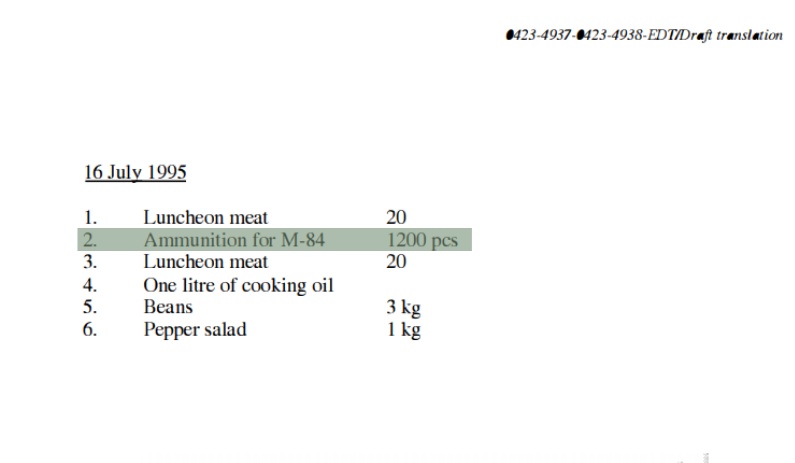
Members of the 10th SD used automatic weapons to shoot the prisoners. After the killing of the first bus load of prisoners, Brano Gojković and Aleksandar Cvetković suggested having their rifles replaced by M-84 machine guns to speed up the killings. Due to the destructive potential of the ammunition used, the prisoners were not killed instantly, but wounded – after which, most of them begged to be shot dead.
When the execution had been underway for some time, Brano Gojković and Vladimir Golijan insisted that the drivers of the buses should also take part in the execution so that they would not testify about the crime as eye-witnesses.
At about 13:00 hours, a group of eight members of the Drina Corps Bratunac Brigade, including Radenko Tomić a.k.a. “Gargija”, arrived at the Branjevo farm. They beat the prisoners with metal bars and gun barrels, humiliated them and made them perform Muslim prostrations. They continued executing Muslim prisoners, while the members of the firing squad of the 10th Sabotage Detachment stood by and watched.
The mass execution at the Branjevo farm went on from 10:00 to 16:00 hours. Acting on orders from Major Dragomir Pećanac and Lieutenant Milorad Pelemiš, members of the 10th SD killed approximately 1,200 Muslim prisoners from Srebrenica at the Branjevo farm.
After the execution, the Lieutenant-Colonel who earlier that day had shown the way to the Branjevo farm to the members of the 10th SD returned to Branjevo, and said that there were around 500 more prisoners in the Cultural Centre in Pilica who had to be executed too. As the members of the 10th SD refused to do this, soldiers from the Bratunac Brigade went to the Cultural Centre instead of them.
The mass grave at the Branjevo military farm was discovered in 1996. The bodies of the prisoners killed in the Cultural Centre in Pilica were found together with the bodies of those killed at the farm. They were all men, and all but one wore civilian clothes. Their identity was established through DNA analyses. When it became possible to determine the cause of death, it was established that the men died as a result of gunshot injuries. Also, four secondary graves were discovered in sites on the Čančari Road, and DNA connections were established between these graves and the primary grave at Branjevo.
23 July 1995: Execution of Muslim prisoners in Bišina
In his testimony before the ICTY, Dražen Erdemović stated that Radoslav Kremenović had told him that on 22 July 1995 Petar Salapura came to Dragaševac and together with Milorad Pelemiš tried to convince a group of members of the 10th Sabotage Detachment to carry out an assignment. Kremenović further told Erdemović that he had refused to carry out that order because he did not want to allow Salapura to “drag him into his dirty business”.
The next day, 23 July, Momo Amović, Commander of the Administration of the Drina Corps Staff, ordered one of his subordinates to pick up five or six soldiers in Dragaševac and drive them to Bišina by minibus.
Later that day, a member of the military police battalion of the Drina Corps was ordered to pick up prisoners from the prison in Sušica. He and another two soldiers from his unit put the prisoners onto a truck, and drove them towards Šekovići. Another truck and a minibus joined them on the way, as well as Vujadin Popović in a Volkswagen Golf.
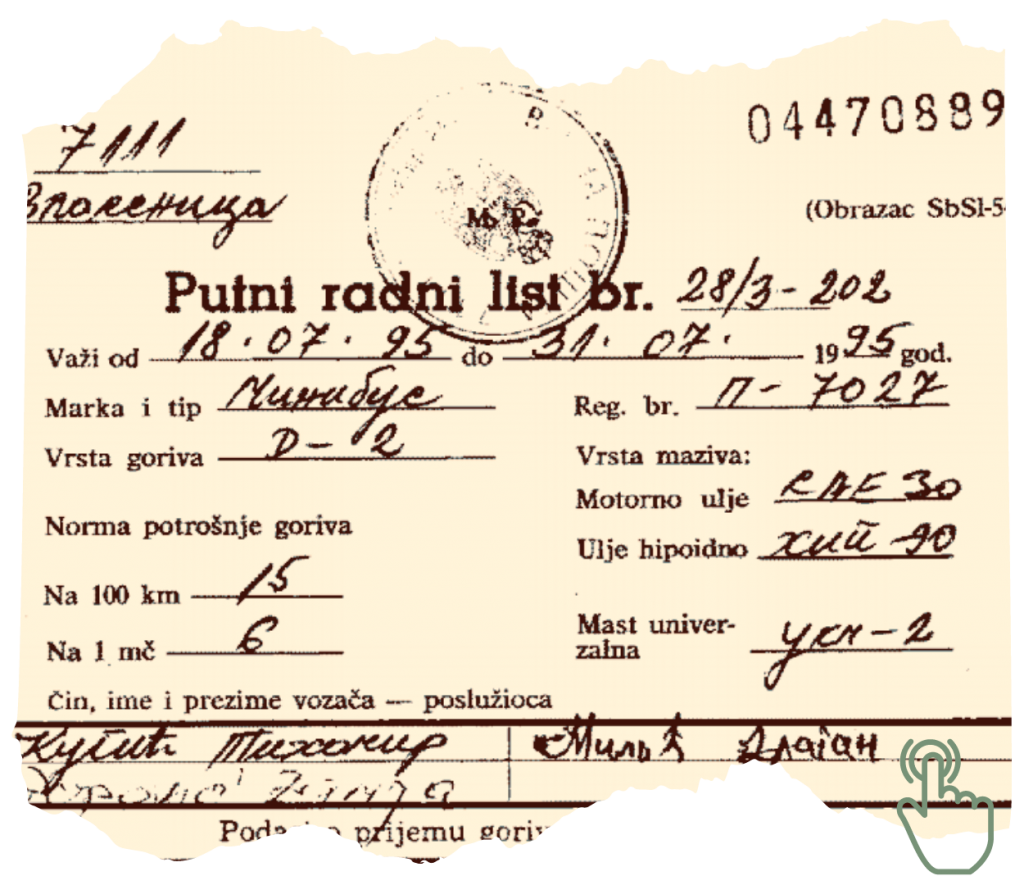
(ICTY translation, original)
This convoy of vehicles stopped some 200 or 300 metres from the command post of the Bišina Battalion of the 1st Birčani Brigade. Five or six soldiers got off of the minibus. Some of them wore the insignia of the 10th Sabotage Detachment. After a brief conversation with Vujadin Popović, they opened the rear door to the truck and dragged out five prisoners. They took them 30 metres away from the parked vehicles and killed them by firing from their automatic rifles. The remaining prisoners were then taken from the truck in groups of five, and killed by the members of the 10th Sabotage Detachment.
At the location of the primary mass grave in the village of Bišina, the mortal remains of 39 people were found. They were blindfolded, and their hands were tied with wire.
The identity of the soldiers who took part in the killing of these prisoners is still unknown.
Operations of the 10th Sabotage Detachment after the fall of Srebrenica
Some 15 members of the 10th Sabotage Detachment from both platoons, under the command of Milorad Pelemiš, participated alongside other VRS units in the takeover of the UN protected area of Žepa, as part of Operation Stupčanica-95. Their primary task was to guard and control a bridge which was an entry point into Žepa. The VRS took control of the Žepa safe area on 28 July 1995.
Following the takeover of Žepa, and pursuant to orders from Colonel Salapura, the 10th SD was deployed to Bosanska Krajina and stayed there until the end of the war in BiH, occasionally returning to its base. While the detachment was in Bosanska Krajina, members of the Serbian State Security Service maintained communication with Pelemiš.
Promotions
On the occasion of celebrating the anniversary of the formation of the 10th Sabotage Detachment on 14 October 1995, General Radislav Krstic, Commander of the VRS Drina Corps, on behalf of the VRS Main Staff, congratulated the detachment on all successfully completed tasks. On that same occasion, members of the detachment who participated in the killings at Branjevo were promoted to higher ranks.
Request for issuing fake ID cards to eight members of the 10th Sabotage Detachment
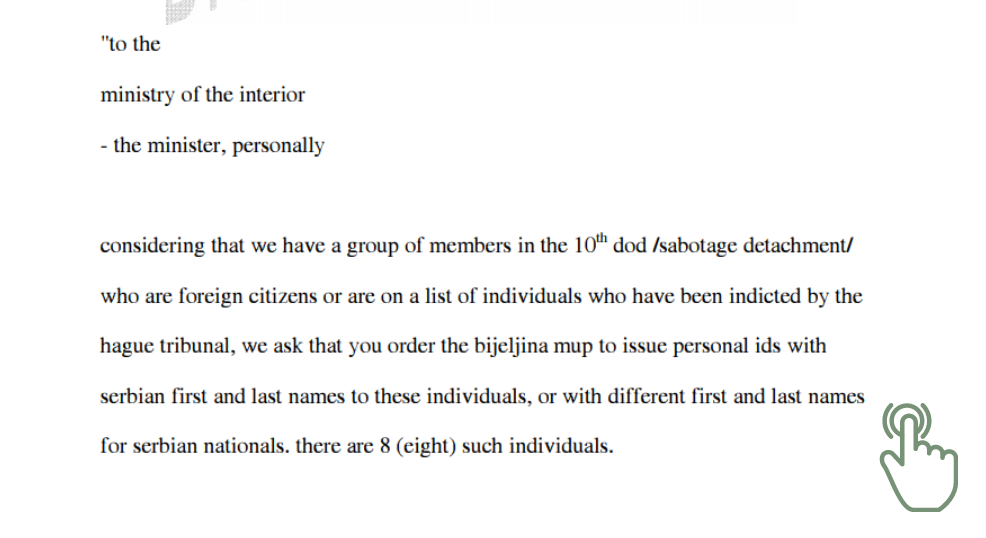
On 16 January 1996, Colonel Petar Salapura sent a dispatch to the Ministry of the Interior of Republika Srpska directly requesting that eight members of the 10th Sabotage Detachment who had taken part in the killing of prisoners in Branjevo be issued ID cards to be able to escape to Serbia.
Dispatch – Petar Salapura, dated 14 January 1996
(ICTY translation, original)
10th Sabotage Detachment: commanders and executioners
To date, seven members of the 10th Sabotage Detachment have been convicted by the ICTY and domestic courts in Serbia and Bosnia and Herzegovina of crimes committed in July 1995 at the military farm in Branjevo. These are: Dražen Erdemović, Franc Kos, Vlastimir Golijan, Stanko Savanović/Stanko Kojić, Zoran Goronja, Marko Boškić, and Brano Gojković.
No member of the 10th SD has been held to account for the killings committed in Bišina.
On 16 August 2016, the Humanitarian Law Center filed a criminal complaint with the Office of the War Crimes Prosecutor of the Republic of Serbia against several individuals, including members of the 10th Sabotage Detachment, reasonably suspected of ordering or perpetrating the criminal act of genocide. The 10th SD members listed in the complaint are: Petar Salapura, Dragomir Pećanac, Milorad Pelemiš, Radoslav Kremenović, Franc Kos, Brano Gojković, Stanko Savanović, Vlastimir Golijan, Zoran Goronja, Aleksandar Cvetković, Marko Boškić, and Zoran Obrenović a.k.a. “Maljić”. Petar Salapura, Dragomir Pećanac, Radoslav Kremenović and Zoran Obrenović are still at large, but within reach of the competent authorities of the Republic of Serbia.
Petar Salapura
(b. 20 August 1948 in Bjelaj, Bosanski Petrovac, BiH)
Petar Salapura served as the Chief of the VRS Main Staff Intelligence Administration from its establishment in May 1992 until Salapura’s retirement in 1997. He was among the officers whose status was regulated through the Yugoslav Army 30th Personnel Centre.
In addition to the previously mentioned operations of the 10th Sabotage Detachment, Colonel Salapura also issued orders regarding the internal relations within this unit. Namely, before the attack on Srebrenica, Petar Salapura gave a verbal order to Pelemiš to have the following members of the unit killed because they talked too much about the activities of the unit: Zijad Žigić, Mladen Marinović, Marko Boškić and Dražen Erdemović.
On the night of 22-23 July 1995 in Bijeljina, Stanko Savanović, a member of the 10th SD, shot at Dražen Erdemović, Radoslav Kremenović and Zijad Žigić. Dražen Erdemović was struck in the chest and stomach, whilst the other two were unharmed.
During Operation Krivaja-95, Salapura was present at the football field in Nova Kasaba on the morning of 13 July 1995 – that is, at the time when over 500 Muslim prisoners were being held there to be killed the next day near Zvornik. On the afternoon of 13 July, Salapura joined Mladić in Srebrenica. For the rest of the operation, Salapura was stationed at the VRS Main Staff headquarters in Crna Rijeka, from where he coordinated the work of the Intelligence Administration.
Colonel Petar Salapura currently lives in Serbia as a retired colonel.
Dragomir Pećanac
(b. 6 June 1964 in Sarajevo, BiH)
In July 1995, Dragomir Pećanac served as Ratko Mladić’s personal adjutant. His status was regulated through the VJ 30th Personnel Centre.
He lives in Belgrade as a retired major.
Milorad Pelemiš
(b. 30 August 1964 in Pelemiši, Kladanj, BiH – d. 23 April 2021 in Belgrade, Serbia)
As a member of the VJ Special Units Corps, Pelemiš was in March 1994 33 temporarily assigned to the VRS. From 14 October 1994 until the end of the war in BiH, he was the commander of the VRS MS 10th Sabotage Detachment. He participated in the armed conflict in Kosovo as a member of the “Pauk” [Spider] group.
After the war he lived in Belgrade, where he died in April 2021.
Franc Kos
(b. 16 July 1966 in Celje, Slovenia)
Franc Kos came to Bosnia in January 1993 and joined the Army of BiH as a soldier of the 3rd Platoon of the 2nd Battalion of the Tuzla Brigade. In early October 1993, he was arrested by the ABiH military police for helping some Serbs to cross into Republika Srpska. After spending forty days in custody, Kos fled to Serb-controlled territory, where he was arrested and detained in the Batković camp.
Kos was released from the camp in February 1994 as a member of a 7-strong group led by Captain Zoran Manojlović, which included Zijad Žigić, Stjepo Pranić and Dražen Erdemović. The group operated under the command of the VRS MS Intelligence Administration, i.e., under its chief, Colonel Petar Salapura, and was tasked with carrying out diversionary operations behind enemy lines.
The group was dissatisfied with not being officially part of the VRS. Moreover, the group disagreed with the Main Staff’s plans to expand its tasks to include the capture of men in enemy territory who would later be transferred to VRS-controlled areas for questioning. All these factors led to the restructuring of the group and the formation of the 10th Sabotage Detachment. Franc Kos was the commander of its 1st (so-called Bijeljina) platoon.
After the war, Kos lived in Bijeljina, BiH. Under a mercenary contract brokered by the Serbian State Security Service, he obtained a three-month military engagement in Zaire in 1997. He was arrested on 20 April 2010 when trying to enter Croatia from Serbia at a border crossing near Osijek.
Franc Kos, Commander of the 1st platoon, and Stanko Savanović (Kojić), Zoran Goronja, and Vlastimir Golijanin, all former members of the 10th Sabotage Detachment, were sentenced by the Court of BiH to 35, 32, 30 and 15 years in prison respectively for the crimes against humanity they committed in June and July 1995.
Marko Boškić
(b. 9 July 1964 in Tuzla, BiH)
Marko Boškić was arrested in 1993 when trying to flee from BiH to Serbia, and spent some time in the Batković prison camp. In June 1994, he became a member of the diversionary group led by Captain Zoran Manojlović, and in October the same year he became part of the 10th SD.
After the war, he spent a year and a half in Serbia, living in Sremska Mitrovica and Belgrade. In late 1997 he moved to Germany, and in 2000 to the United States. Four years later, he was arrested on suspicions of killing a U.S. citizen in Boston while driving under the influence of alcohol. Boškić was sentenced to five years imprisonment in the U.S. for crimes committed there and for lying on his refugee application and concealing his role in the massacres in Srebrenica. After serving his sentence in the U.S., he was deported to BiH.
After concluding a plea agreement with the Prosecutor’s Office of Bosnia and Herzegovina, Marko Boškić was sentenced to 10 years in prison.
Dražen Erdemović
(b. 25 November 1971 in Donja Dragunja, Tuzla, BiH)
Erdemović was a member of the HVO military police until October 1993, when he was punished for helping Serbs from Donja Dragunja cross the border into Republika Srpska. In April 1994 he joined the diversionary group led by Zoran Manojlović. From 14 October 1994 till the end of the war in BiH, he was a member of the 10th Sabotage Detachment.
Erdemović was arrested in Serbia in March 1996 on suspicion of having committed a war crime against civilians and soon afterwards extradited to the ICTY, where he confessed to taking part in the execution of 1,200 Bosnian Muslims at the Branjevo military farm on 16 July 1995. The ICTY Trial Chamber sentenced him to five years in prison for violating the rules and customs of war. The sentence was final and binding.
Brano Gojković
(b. 4 October 1968 in Starić, Kladanj, BiH)
Gojković was a member of the Vlasenica Platoon of the 10th Sabotage Detachment. After the war in BiH, he fought as a mercenary in Zaire, Kosovo, and Northern Macedonia.
The Office of the War Crimes Prosecutor of the Republic of Serbia (OWCP) brought charges against him in January 2016, but only after BiH sought his extradition. Gojković was charged as a member of the VRS 10th Sabotage Detachment with killing, jointly with other members of the detachment, several hundred captured Bosnian Muslim civilians from Srebrenica.
The Higher Court in Belgrade on 27 January 2016 confirmed the plea agreement that Brano Gojković had concluded with the OWCP and sentenced him to 10 years in prison.
Aleksandar Cvetković
(b. 4 April 1968 in Tuzla, BiH)
Aleksandar Cvetković in 2006 emigrated to Israel and became an Israeli citizen. Pursuant to the BiH’s extradition law, Cvetković was arrested in Israel and soon afterwards extradited to BiH.
The Court of BiH acquitted Cvetković of the charge of participating, as a member of the 10th Sabotage Detachment, in the first attack on the Srebrenica safe area and the UNPROFOR base in late June 1995, and participating in the takeover of the Srebrenica safe area on 11 July 1995. Cvetković was also acquitted of participating in the killings of at least 900 captured Bosnian Muslim men and boys from the Srebrenica enclave at the Branjevo farm on 16 July. According to the indictment against him, Cvetković, alongside other members of the 10th Sabotage Detachment, fired from an automatic rifle at the prisoners who were arriving in groups of 10. Only two prisoners survived the massacre.
Radoslav Kremenović
(b. 16 October 1967 in Bistrica, Banja Luka, BiH)
Radoslav Kremenović, a member of the Vlasenica Platoon of the 10th Sabotage Detachment, was arrested in March 1996 together with Dražen Erdemović. After being interrogated because of his harbouring Erdemović and illegal possession of arms and ammunition, which he kept in his house in Bečej, Serbia, he was released without being charged.
He currently lives in Serbia.
Zoran Obrenović a.k.a. “Maljić”
(b. 22 January 1971 in Piskavci, Vlasenica, BiH)
Obrenović was a member of the VRS assault detachment from 1992 to 1993. He got his nickname “Maljić” because he would kill captured Bosnian Muslims with a large hammer (“malj” in Serbian).
He currently lives in Serbia.
Zoran Obrenović is on the Interpol Red Notice list.

Humanitarian Law Center, July 2021






